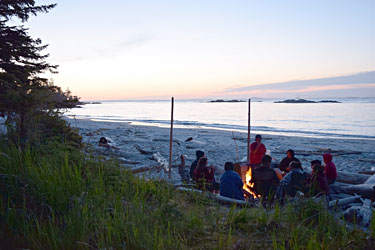
High school students learn traditional skills on a SEAS Outdoors Club camping trip to Goose Island in Heiltsuk territory. Photo credit: Johanna Gordon-Walker.
Raised on a gillnetter in a fisher family, Howard Humchitt spent most of his childhood on the water learning how to harvest Heiltsuk Nation marine resources. “It’s a way of life for us,” he explains. “For many parents who own boats, their kids get their sea legs early. They get a feel for the ocean under their feet before they’re even walking.”
For families who don’t own boats or lack the resources to get out on the water, Howard says the Supporting Emerging Aboriginal Stewards (SEAS) initiative fills a gap. As a SEAS Outdoors Club mentor in Heiltsuk territory, he says the program helps prepare First Nations youth to become the next generation of stewards in their communities.
“The SEAS outdoor program has given me a huge opportunity to pass on the knowledge that I’ve been taught by my father, uncles and brothers to others,” he says. “We help kids to get out and be a part of the land and a part of the ocean.”
First started in 2009, SEAS is active in the Heiltsuk, Kitasoo, Nuxalk and Wuikinuxv First Nations communities of the Central Coast of British Columbia. Classroom and outdoor activities are designed to cultivate a deeper understanding of traditional cultural beliefs and marine values.
“It keeps our kids in touch with who we are as a people,” Howard affirms. “We’ve always been a part of the ocean. It’s a mainstay of our diet.”
In line with the goals of the Marine Plan Partnership (MaPP), the SEAS Outdoors Club helps foster ocean stewardship. High school students learn practical skills in fishing, wilderness first aid and boat safety. They visit ancient clam middens and learn how important ocean resources have been to their community for thousands of years.
“Stewardship is something that is learned by being out on the land and the water,” says SEAS instructor Johanna Gordon-Walker. “Students are picking up the skills needed to become young leaders and the confidence to share their skills. They know how to make a fire and cook over it and they learn the territory well enough to know which way to go in a boat.”
The Central Coast Marine Plan includes objectives and strategies aimed at protecting and sustaining the region’s rich traditional and cultural resources by engaging young people in traditional use activities. SEAS brings elders into the classroom to demonstrate how to use plants as medicine and to teach the cultural protocols for sharing harvests with the community. Grade 4 students study herring science on the water. They learn how to set tree branches for herring roe and to preserve the eggs.
“The thing that really sticks with you most is the wonder and awe factor,” says Johanna. “It’s a huge adventure for the younger children to go out on a boat for the day. The more they learn, the more questions they have.”
Funding for MaPP supports SEAS program coordination, cultivating the next generation of stewards to carry out marine plan implementation. On this year’s first winter camping trip, students job-shadowed commercial crab and prawn fishers.
At the end of the SEAS program, some graduates aspire to work with the coastal guardian watchmen or the Coast Guard. For others, learning to harvest ocean resources for their families makes them feel appreciated and gives them a productive role in their communities.
The experience is rewarding for Howard, too.
“When the students see something for the first time, I take joy in seeing their eyes light up,” Howard recounts. “When somebody sees a wolf for the first time, I realise it’s not just another wolf. It’s the first wolf this person is seeing. Every one of these opportunities make me appreciate what we have and allows me to see something for the first time– again.”



